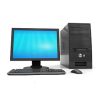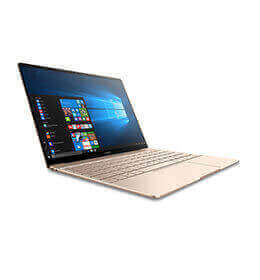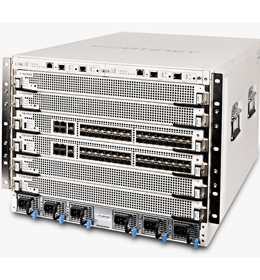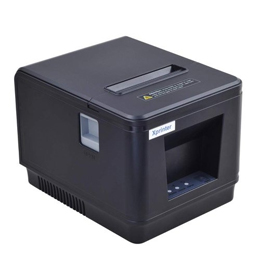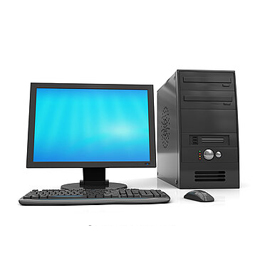Laptop
A laptop, laptop computer, or notebook computer is a small, portable personal computer (PC) with a screen and alphanumeric keyboard. Laptops typically have a clam shell form factor with the screen mounted on the inside of the upper lid and the keyboard on the inside of the lower lid, although 2-in-1 PCs with a detachable keyboard are often marketed as laptops or as having a “laptop mode”.[1][2] Laptops are folded shut for transportation, and thus are suitable for mobile use.[3] They are so named because they can be practically placed on a person’s lap when being used. Today, laptops are used in a variety of settings, such as at work, in education, for playing games, web browsing, for personal multimedia, and for general home computer use.o.
Description
History
As the personal computer (PC) became feasible in 1971, the idea of a portable personal computer soon followed. A “personal, portable information manipulator” was imagined by Alan Kay at Xerox PARC in 1968,[7] and described in his 1972 paper as the “Dynabook“.[8] The IBM Special Computer APL Machine Portable (SCAMP) was demonstrated in 1973.[9] This prototype was based on the IBM PALM processor.[10] The IBM 5100, the first commercially available portable computer, appeared in September 1975, and was based on the SCAMP prototype.[11]
The Epson HX-20, the first “laptop computer”, was invented in 1980 and introduced in 1981
As 8-bit CPU machines became widely accepted, the number of portables increased rapidly. The first “laptop-sized notebook computer” was the Epson HX-20,[12][13] invented (patented) by Suwa Seikosha‘s Yukio Yokozawa in July 1980,[14] introduced at the COMDEX computer show in Las Vegas by Japanese company Seiko Epson in 1981,[15][13] and released in July 1982.[13][16] It had an LCD screen, a rechargeable battery, and a calculator-size printer, in a 1.6 kg (3.5 lb) chassis, the size of an A4 notebook.[13] It was described as a “laptop” and “notebook” computer in its patent.[14]
The portable micro computer Portal of the French company R2E Micral CCMC officially appeared in September 1980 at the Sicob show in Paris. It was a portable microcomputer designed and marketed by the studies and developments department of R2E Micral at the request of the company CCMC specializing in payroll and accounting. It was based on an Intel 8085 processor, 8-bit, clocked at 2 MHz. It was equipped with a central 64 KB RAM, a keyboard with 58 alphanumeric keys and 11 numeric keys (separate blocks), a 32-character screen, a floppy disk: capacity = 140,000 characters, of a thermal printer: speed = 28 characters / second, an asynchronous channel, asynchronous channel, a 220 V power supply. It weighed 12 kg and its dimensions were 45 × 45 × 15 cm. It provided total mobility. Its operating system was aptly named Prologue.
The Osborne 1, released in 1981, was a luggable computer that used the Zilog Z80 CPU and weighed 24.5 pounds (11.1 kg).[17] It had no battery, a 5 in (13 cm) cathode-ray tube (CRT) screen, and dual 5.25 in (13.3 cm) single-density floppy drives. Both Tandy/RadioShack and Hewlett-Packard (HP) also produced portable computers of varying designs during this period.[18][19] The first laptops using the flip form factor appeared in the early 1980s. The Dulmont Magnum was released in Australia in 1981–82, but was not marketed internationally until 1984–85. The US$8,150 (equivalent to $22,880 in 2021) GRiD Compass 1101, released in 1982, was used at NASA and by the military, among others. The Sharp PC-5000,[20] Ampere[21] and Gavilan SC released in 1983. The Gavilan SC was described as a “laptop” by its manufacturer,[22] while the Ampere had a modern clamshell design.[21][23] The Toshiba T1100 won acceptance not only among PC experts but the mass market as a way to have PC portability.[24]
From 1983 onward, several new input techniques were developed and included in laptops, including the touch pad (Gavilan SC, 1983), the pointing stick (IBM ThinkPad 700, 1992), and handwriting recognition (Linus Write-Top,[25] 1987). Some CPUs, such as the 1990 Intel i386SL, were designed to use minimum power to increase battery life of portable computers and were supported by dynamic power management features such as Intel SpeedStep and AMD PowerNow! in some designs.
Displays reached 640×480 (VGA) resolution by 1988 (Compaq SLT/286), and color screens started becoming a common upgrade in 1991,[26] with increases in resolution and screen size occurring frequently until the introduction of 17″ screen laptops in 2003. Hard drives started to be used in portables, encouraged by the introduction of 3.5″ drives in the late 1980s, and became common in laptops starting with the introduction of 2.5″ and smaller drives around 1990; capacities have typically lagged behind physically larger desktop drives.
Common resolutions of laptop webcams are 720p (HD), and in lower-end laptops 480p.[27] The earliest known laptops with 1080p (Full HD) webcams like the Samsung 700G7C were released in the early 2010s.[28]
Optical disc drives became common in full-size laptops around 1997; this initially consisted of CD-ROM drives, which were supplanted by CD-R, DVD, and Blu-ray drives with writing capability over time. Starting around 2011, the trend shifted against internal optical drives, and as of 2022, they have largely disappeared, but are still readily available as external peripherals.
Etymology
While the terms laptop and notebook are used interchangeably today, there is some question as to the original etymology and specificity of either term. The term laptop appears to have been coined in the early 1980s to describe a mobile computer which could be used on one’s lap and to distinguish these devices from earlier and much heavier portable computers (informally called “luggables”). The term notebook appears to have gained currency somewhat later as manufacturers started producing even smaller portable devices, further reducing their weight and size and incorporating a display roughly the size of A4 paper;[5] these were marketed as notebooks to distinguish them from bulkier mainstream or desktop replacement laptops.
Types of laptops
Compaq Armada laptop from the late 1990s
Apple MacBook Air, an “ultraportable” laptop weighing under 3.0 lb (1.36 kg)
Asus Transformer Pad, a hybrid tablet, powered by Android OS
Microsoft Surface Pro 3, 2-in-1 detachable
Samsung Sens laptop
Panasonic Toughbook CF-M34, a rugged laptop/subnotebook
Since the introduction of portable computers during the late 1970s, their form has changed significantly, spawning a variety of visually and technologically differing subclasses. Except where there is a distinct legal trademark around a term (notably, Ultrabook), there are rarely hard distinctions between these classes and their usage has varied over time and between different sources. Since the late 2010s, the use of more specific terms has become less common, with sizes distinguished largely by the size of the screen.
Smaller and larger laptops
Main articles: Subnotebook and Desktop replacement computer
There were in the past a number of marketing categories for smaller and larger laptop computers; these included “subnotebook” models, low cost “netbooks“, and “ultra-mobile PCs” where the size class overlapped with devices like smartphone and handheld tablets, and “Desktop replacement” laptops for machines notably larger and heavier than typical to operate more powerful processors or graphics hardware.[29] All of these terms have fallen out of favor as the size of mainstream laptops has gone down and their capabilities have gone up; except for niche models, laptop sizes tend to be distinguished by the size of the screen, and for more powerful models, by any specialized purpose the machine is intended for, such as a “gaming laptop” or a “mobile workstation” for professional use.
Convertible, hybrid, 2-in-1
The latest trend of technological convergence in the portable computer industry spawned a broad range of devices, which combined features of several previously separate device types. The hybrids, convertibles, and 2-in-1s emerged as crossover devices, which share traits of both tablets and laptops. All such devices have a touchscreen display designed to allow users to work in a tablet mode, using either multi-touch gestures or a stylus/digital pen.
Convertibles are devices with the ability to conceal a hardware keyboard. Keyboards on such devices can be flipped, rotated, or slid behind the back of the chassis, thus transforming from a laptop into a tablet. Hybrids have a keyboard detachment mechanism, and due to this feature, all critical components are situated in the part with the display. 2-in-1s can have a hybrid or a convertible form, often dubbed 2-in-1 detachable and 2-in-1 convertibles respectively, but are distinguished by the ability to run a desktop OS, such as Windows 10. 2-in-1s are often marketed as laptop replacement tablets.[30]
2-in-1s are often very thin, around 10 millimetres (0.39 in), and light devices with a long battery life. 2-in-1s are distinguished from mainstream tablets as they feature an x86-architecture CPU (typically a low- or ultra-low-voltage model), such as the Intel Core i5, run a full-featured desktop OS like Windows 10, and have a number of typical laptop I/O ports, such as USB 3 and Mini DisplayPort.
2-in-1s are designed to be used not only as a media consumption device but also as valid desktop or laptop replacements, due to their ability to run desktop applications, such as Adobe Photoshop. It is possible to connect multiple peripheral devices, such as a mouse, keyboard, and several external displays to a modern 2-in-1.
Microsoft Surface Pro-series devices and Surface Book are examples of modern 2-in-1 detachable, whereas Lenovo Yoga-series computers are a variant of 2-in-1 convertibles. While the older Surface RT and Surface 2 have the same chassis design as the Surface Pro, their use of ARM processors and Windows RT do not classify them as 2-in-1s, but as hybrid tablets.[31] Similarly, a number of hybrid laptops run a mobile operating system, such as Android. These include Asus’s Transformer Pad devices, examples of hybrids with a detachable keyboard design, which do not fall in the category of 2-in-1s.
Rugged laptop
A rugged laptop is designed to reliably operate in harsh usage conditions such as strong vibrations, extreme temperatures, and wet or dusty environments. Rugged laptops are bulkier, heavier, and much more expensive than regular laptops,[32] and thus are seldom seen in regular consumer use.
Hardware
|
This section needs additional citations for verification. (July 2016)
|
Inner view of a MacBook (Retina) laptop
A SODIMM memory module
The basic components of laptops function identically to their desktop counterparts. Traditionally they were miniaturized and adapted to mobile use, The design restrictions on power, size, and cooling of laptops limit the maximum performance of laptop parts compared to that of desktop components, although that difference has increasingly narrowed.[33]
In general, laptop components are not intended to be replaceable or upgradable by the end-user, except for components that can be detached; in the past, batteries and optical drives were commonly exchangeable. This restriction is one of the major differences between laptops and desktop computers, because the large “tower” cases used in desktop computers are designed so that new motherboards, hard disks, sound cards, RAM, and other components can be added. Memory and storage can often be upgraded with some disassembly, but with the most compact laptops, there may be no upgradeable components at all.[34]
The following sections summarizes the differences and distinguishing features of laptop components in comparison to desktop personal computer parts.[35]
Display
Types of displays
Internally: Technology
Internally, a display was usually a Liquid-crystal display (LCD) panel, although occasionally organic light-emitting diode (OLED)s are used. Since 2020, more and more laptops with OLED screens are being released relative to models with LCD screens.
The display interfaces to the laptop using the Low-voltage differential signaling (LVDS) or embedded DisplayPort protocol.
Externally: Surface
Externally, it can be a glossy or a matte (anti-glare) screen.
Sizes
In the past, there was a broader range of marketing terms (both formal and informal) to distinguish between different sizes of laptops. These included Netbooks, subnotebooks, Ultra-mobile PC, and Desktop replacement computers; these are sometimes still used informally, although they are essentially dead in terms of manufacturer marketing.
As of 2021, mainstream consumer laptops tend to come with 11″, 13″ or 15″-16″ screens; 14″ models are more popular among business machines. Larger and smaller models are available, but less common – there is no clear dividing line in minimum or maximum size. Machines small enough to be handheld (screens in the 6–8″ range) can be marketed either as very small laptops or “handheld PCs,” while the distinction between the largest laptops and “All-in-One” desktops is whether they fold for travel.
Resolution
Having a higher resolution display allows more items to fit onscreen at a time, improving the user’s ability to multitask, although at the higher resolutions on smaller screens, the resolution may only serve to display sharper graphics and text rather than increasing the usable area. Since the introduction of the MacBook Pro with Retina display in 2012, there has been an increase in the availability of “HiDPI” (or high Pixel density) displays; as of 2022, this is generally considered to be anything higher than 1920 pixels wide. This has increasingly converged around 4K (3840-pixel-wide) resolutions.
External displays can be connected to most laptops, with most models supporting at least one.[36] The use of technology such as USB4 (section Alternate Mode partner specifications)|DisplayPort Alt Mode]] has been utilized to charge a laptop and provide display output over one USB-C Cable.[37]
Refresh rates and 3D
The earliest laptops known to feature a display with doubled 120 Hz of refresh rate and active shutter 3D system were released in 2011 by Dell (M17x) and Samsung (700G7A).[38][39]
Central processing unit (CPU)
A laptop’s CPU has advanced power-saving features and produces less heat than one intended purely for desktop use. Mainstream laptop CPUs made after 2018 have at least two processor cores, often four cores, and sometimes more, with 8 cores becoming more common.
For the low price and mainstream performance, there is no longer a significant performance difference between laptop and desktop CPUs, but at the high end, the fastest desktop CPUs still substantially outperform the fastest laptop processors, at the expense of massively higher power consumption and heat generation; the fastest laptop processors top out at 56 watts of heat, while the fastest desktop processors top out at 150 watts (and often need water cooling).
There has been a wide range of CPUs designed for laptops available from both Intel, AMD, and other manufacturers. On non-x86 architectures, Motorola and IBM produced the chips for the former PowerPC-based Apple laptops (iBook and PowerBook). Between around 2000 to 2014, most full-size laptops had socketed, replaceable CPUs; on thinner models, the CPU was soldered on the motherboard and was not replaceable or upgradable without replacing the motherboard. Since 2015, Intel has not offered new laptop CPU models with pins to be interchangeable, preferring ball grid array chip packages which have to be soldered;[40] and as of 2021, only a few rare models using desktop parts.
In the past, some laptops have used a desktop processor instead of the laptop version and have had high-performance gains at the cost of greater weight, heat, and limited battery life; this is not unknown as of 2022, but since around 2010, the practice has been restricted to small-volume gaming models. Laptop CPUs are rarely able to be overclocked; most use locked processors. Even on gaming models where unlocked processors are available, the cooling system in most laptops is often very close to its limits and there is rarely headroom for an overclocking–related operating temperature increase.
Graphical processing unit
On most laptops, a graphical processing unit (GPU) is integrated into the CPU to conserve power and space. This was introduced by Intel with the Core i-series of mobile processors in 2010, and similar accelerated processing unit (APU) processors by AMD later that year.
Before that, lower-end machines tended to use graphics processors integrated into the system chipset, while higher-end machines had a separate graphics processor. In the past, laptops lacking a separate graphics processor were limited in their utility for gaming and professional applications involving 3D graphics, but the capabilities of CPU-integrated graphics have converged with the low-end of dedicated graphics processors since the mid-2010s.
Higher-end laptops intended for gaming or professional 3D work still come with dedicated and in some cases even dual, graphics processors on the motherboard or as an internal expansion card. Since 2011, these almost always involve switchable graphics so that when there is no demand for the higher performance dedicated graphics processor, the more power-efficient integrated graphics processor will be used. Nvidia Optimus and AMD Hybrid Graphics are examples of this sort of system of switchable graphics.
Memory
Since around the year 2000, most laptops have used SO-DIMM RAM,[35] although, as of 2021, an increasing number of models use memory soldered to the motherboard. Before 2000, most laptops used proprietary memory modules if their memory was upgradable.
In the early 2010s, high end laptops such as the 2011 Samsung 700G7A have passed the 10 GB RAM barrier, featuring 16 GB of RAM.[41]
When upgradeable, memory slots are sometimes accessible from the bottom of the laptop for ease of upgrading; in other cases, accessing them requires significant disassembly. Most laptops have two memory slots, although some will have only one, either for cost savings or because some amount of memory is soldered. Some high-end models have four slots; these are usually mobile engineering workstations, although a few high-end models intended for gaming do as well.
As of 2021, 8 GB RAM is most common, with lower-end models occasionally having 4GB. Higher-end laptops may come with 16 GB of RAM or more.
Internal storage
The earliest laptops most often used floppy disk for storage, although a few used either RAM disk or tape, by the late 1980s hard disk drives had become the standard form of storage.
Between 1990 and 2009, almost all laptops typically had a hard disk drive (HDD) for storage; since then, solid-state drives (SSD) have gradually come to supplant hard drives in all but some inexpensive consumer models. Solid-state drives are faster and more power-efficient, as well as eliminating the hazard of drive and data corruption caused by a laptop’s physical impacts, as they use no mechanical parts such as a rotational platter.[42] In many cases, they are more compact as well. Initially, in the late 2000s, SSDs were substantially more expensive than HDDs, but as of 2021 prices on smaller capacity (under 1 terabyte) drives have converged; larger capacity drives remain more expensive than comparable-sized HDDs.
Since around 1990, where a hard drive is present it will typically be a 2.5-inch drive; some very compact laptops support even smaller 1.8-inch HDDs, and a very small number used 1″ Microdrives. Some SSDs are built to match the size/shape of a laptop hard drive, but increasingly they have been replaced with smaller mSATA or M.2 cards. SSDs using the newer and much faster NVM Express standard for connecting are only available as cards.
As of 2022, many laptops no longer contain space for a 2.5″ drive, accepting only M.2 cards; a few of the smallest have storage soldered to the motherboard. For those that can, they can typically contain a single 2.5-inch drive, but a small number of laptops with a screen wider than 15 inches can house two drives.
A variety of external HDDs or NAS data storage servers with support of RAID technology can be attached to virtually any laptop over such interfaces as USB, FireWire, eSATA, or Thunderbolt, or over a wired or wireless network to further increase space for the storage of data. Many laptops also incorporate a SD or microSD card slot. This enables users to download digital pictures from an SD card onto a laptop, thus enabling them to delete the SD card’s contents to free up space for taking new pictures.
Removable media drive
Optical disc drives capable of playing CD-ROMs, compact discs (CD), DVDs, and in some cases, Blu-ray discs (BD), were nearly universal on full-sized models between the mid-1990s and the early 2010s. As of 2021, drives are uncommon in compact or premium laptops; they remain available in some bulkier models, but the trend towards thinner and lighter machines is gradually eliminating these drives and players – when needed they can be connected via USB instead.
Inputs
Closeup of a TrackPoint cursor and UltraNav buttons on a ThinkPad laptop
Interfaces on a ThinkPad laptop (2011): Ethernet network port (center), VGA (left), DisplayPort (top right) and USB 2.0 (bottom right). Due to the trend towards very flat laptops and the widespread use of WLAN, the relatively high Ethernet socket is no longer mandatory in today’s devices, as is the technically outdated VGA.
An alphanumeric keyboard is used to enter text, data, and other commands (e.g., function keys). A touchpad (also called a trackpad), a pointing stick, or both, are used to control the position of the cursor on the screen, and an integrated keyboard[43] is used for typing. Some touchpads have buttons separate from the touch surface, while others share the surface. A quick double-tap is typically registered as a click, and operating systems may recognize multi-finger touch gestures.
An external keyboard and mouse may be connected using a USB port or wirelessly, via Bluetooth or similar technology. Some laptops have multitouch touchscreen displays, either available as an option or standard. Most laptops have webcams and microphones, which can be used to communicate with other people with both moving images and sound, via web conferencing or video-calling software.
Laptops typically have USB ports and a combined headphone/microphone jack, for use with headphones, a combined headset, or an external mic. Many laptops have a card reader for reading digital camera SD cards.
Input/output (I/O) ports
On a typical laptop there are several USB ports; if they use only the older USB connectors instead of USB-C, they will typically have an external monitor port (VGA, DVI, HDMI or Mini DisplayPort or occasionally more than one), an audio in/out port (often in form of a single socket) is common. It is possible to connect up to three external displays to a 2014-era laptop via a single Mini DisplayPort, using multi-stream transport technology.[36]
Apple, in a 2015 version of its MacBook, transitioned from a number of different I/O ports to a single USB-C port.[44] This port can be used both for charging and connecting a variety of devices through the use of aftermarket adapters. Apple has since transitioned back to using a number of different ports. Google, with its updated version of Chromebook Pixel, shows a similar transition trend towards USB-C, although keeping older USB Type-A ports for a better compatibility with older devices.[45] Although being common until the end of the 2000s decade, Ethernet network port are rarely found on modern laptops, due to widespread use of wireless networking, such as Wi-Fi. Legacy ports such as a PS/2 keyboard/mouse port, serial port, parallel port, or FireWire are provided on some models, but they are increasingly rare. On Apple‘s systems, and on a handful of other laptops, there are also Thunderbolt ports, but Thunderbolt 3 uses USB-C. Laptops typically have a headphone jack, so that the user can connect headphones or amplified speaker systems for listening to music or other audio.
Expansion cards
In the past, a PC Card (formerly PCMCIA) or ExpressCard slot for expansion was often present on laptops to allow adding and removing functionality, even when the laptop is powered on; these are becoming increasingly rare since the introduction of USB 3.0. Some internal subsystems such as Ethernet, Wi-Fi, or a wireless cellular modem can be implemented as replaceable internal expansion cards, usually accessible under an access cover on the bottom of the laptop. The standard for such cards is PCI Express, which comes in both mini and even smaller M.2 sizes. In newer laptops, it is not uncommon to also see Micro SATA (mSATA) functionality on PCI Express Mini or M.2 card slots allowing the use of those slots for SATA-based solid-state drives.[46]
Battery and power supply
Almost all laptops use smart batteries
Since the late 1990s, laptops have typically used lithium ion or lithium polymer batteries, These replaced the older nickel metal-hydride typically used in the 1990s, and nickel–cadmium batteries used in most of the earliest laptops. A few of the oldest laptops used non-rechargeable batteries, or lead–acid batteries.
Battery life is highly variable by model and workload and can range from one hour to nearly a day. A battery’s performance gradually decreases over time; a noticeable reduction in capacity is typically evident after two to three years of regular use, depending on the charging and discharging pattern and the design of the battery. Innovations in laptops and batteries have seen situations in which the battery can provide up to 24 hours of continued operation, assuming average power consumption levels. An example is the HP EliteBook 6930p when used with its ultra-capacity battery.[47]
Laptops with removable batteries may support larger replacement batteries with extended capacity.
A laptop’s battery is charged using an external power supply, which is plugged into a wall outlet. The power supply outputs a DC voltage typically in the range of 7.2—24 volts. The power supply is usually external and connected to the laptop through a DC connector cable. In most cases, it can charge the battery and power the laptop simultaneously. When the battery is fully charged, the laptop continues to run on power supplied by the external power supply, avoiding battery use. If the used power supply is not strong enough to power computing components and charge the battery simultaneously, the battery may charge in a shorter period of time if the laptop is turned off or sleeping. The charger typically adds about 400 grams (0.88 lb) to the overall transporting weight of a laptop, although some models are substantially heavier or lighter. Most 2016-era laptops use a smart battery, a rechargeable battery pack with a built-in battery management system (BMS). The smart battery can internally measure voltage and current, and deduce charge level and State of Health (SoH) parameters, indicating the state of the cells.[citation needed]
Power connectors
Laptop power supply with cylindrical coaxial DC power connector
Historically, DC connectors, typically cylindrical/barrel-shaped coaxial power connectors have been used in laptops. Some vendors such as Lenovo made intermittent use of a rectangular connector.
Some connector heads feature a center pin to allow the end device to determine the power supply type by measuring the resistance between it and the connector’s negative pole (outer surface). Vendors may block charging if a power supply is not recognized as original part, which could deny the legitimate use of universal third-party chargers.[48]
With the advent of USB-C, portable electronics made increasing use of it for both power delivery and data transfer. Its support for 20 V (common laptop power supply voltage) and 5 A typically suffices for low to mid-end laptops, but some with higher power demands such as gaming laptops depend on dedicated DC connectors to handle currents beyond 5 A without risking overheating, some even above 10 A. Additionally, dedicated DC connectors are more durable and less prone to wear and tear from frequent reconnection, as their design is less delicate.[49]
Cooling
Waste heat from the operation is difficult to remove in the compact internal space of a laptop. The earliest laptops used passive cooling; this gave way to heat sinks placed directly on the components to be cooled, but when these hot components are deep inside the device, a large space-wasting air duct is needed to exhaust the heat. Modern laptops instead rely on heat pipes to rapidly move waste heat towards the edges of the device, to allow for a much smaller and compact fan and heat sink cooling system. Waste heat is usually exhausted away from the device operator towards the rear or sides of the device. Multiple air intake paths are used since some intakes can be blocked, such as when the device is placed on a soft conforming surface like a chair cushion. Secondary device temperature monitoring may reduce performance or trigger an emergency shutdown if it is unable to dissipate heat, such as if the laptop were to be left running and placed inside a carrying case. Aftermarket cooling pads with external fans can be used with laptops to reduce operating temperatures.
Docking station
Docking station and laptop
A docking station (sometimes referred to simply as a dock) is a laptop accessory that contains multiple ports and in some cases expansion slots or bays for fixed or removable drives. A laptop connects and disconnects to a docking station, typically through a single large proprietary connector. A docking station is an especially popular laptop accessory in a corporate computing environment, due to a possibility of a docking station transforming a laptop into a full-featured desktop replacement, yet allowing for its easy release. This ability can be advantageous to “road warrior” employees who have to travel frequently for work, and yet who also come into the office. If more ports are needed, or their position on a laptop is inconvenient, one can use a cheaper passive device known as a port replicator. These devices mate to the connectors on the laptop, such as through USB or FireWire.
Charging trolleys
Laptop charging trolleys, also known as laptop trolleys or laptop carts, are mobile storage containers to charge multiple laptops, netbooks, and tablet computers at the same time. The trolleys are used in schools that have replaced their traditional static computer labs[50] suites of desktop equipped with “tower” computers, but do not have enough plug sockets in an individual classroom to charge all of the devices. The trolleys can be wheeled between rooms and classrooms so that all students and teachers in a particular building can access fully charged IT equipment.[51]
Laptop charging trolleys are also used to deter and protect against opportunistic and organized theft. Schools, especially those with open plan designs, are often prime targets for thieves who steal high-value items. Laptops, netbooks, and tablets are among the highest–value portable items in a school. Moreover, laptops can easily be concealed under clothing and stolen from buildings. Many types of laptop–charging trolleys are designed and constructed to protect against theft. They are generally made out of steel, and the laptops remain locked up while not in use. Although the trolleys can be moved between areas from one classroom to another, they can often be mounted or locked to the floor, support pillars, or walls to prevent thieves from stealing the laptops, especially overnight.[50]
Solar panels
In some laptops, solar panels are able to generate enough solar power for the laptop to operate.[52] The One Laptop Per Child Initiative released the OLPC XO-1 laptop which was tested and successfully operated by use of solar panels.[53] Presently, they are designing an OLPC XO-3 laptop with these features. The OLPC XO-3 can operate with 2 watts of electricity because its renewable energy resources generate a total of 4 watts.[54][55] Samsung has also designed the NC215S solar–powered notebook that will be sold commercially in the U.S. market.[56]
Accessories
A common accessory for laptops is a laptop sleeve, laptop skin, or laptop case, which provides a degree of protection from scratches. Sleeves, which are distinguished by being relatively thin and flexible, are most commonly made of neoprene, with sturdier ones made of low-resilience polyurethane. Some laptop sleeves are wrapped in ballistic nylon to provide some measure of waterproofing. Bulkier and sturdier cases can be made of metal with polyurethane padding inside and may have locks for added security. Metal, padded cases also offer protection against impacts and drops. Another common accessory is a laptop cooler, a device that helps lower the internal temperature of the laptop either actively or passively. A common active method involves using electric fans to draw heat away from the laptop, while a passive method might involve propping the laptop up on some type of pad so it can receive more airflow. Some stores sell laptop pads that enable a reclining person on a bed to use a laptop.

